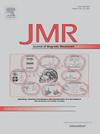多线圈多核应用中宽带去耦电路设计
IF 1.9
3区 化学
Q3 BIOCHEMICAL RESEARCH METHODS
引用次数: 0
摘要
从多核磁共振成像和光谱学中获得的丰富信息在临床环境中很大程度上尚未得到开发。这是由于在获取策略、硬件设计、处理和解释/分析等方面存在大量挑战。作为解决这些挑战的一小部分,这项工作提出了一种直接的线圈间宽带解耦方法。该电路是通过实现串联PIN二极管创建的,并在3t下对1H, 31P和23Na进行了台架和实验评估,单个线圈使用该去耦网络进行单调谐,并堆叠以启用开关三调谐线圈。这些线圈在各种有目的的耦合配置下进行了评估,并与窄带陷阱有源失谐网络进行了比较,以证明该设计的潜在模块化。窄带捕获线圈与其他线圈组合时显示信噪比下降,可能是由于调谐到不同频率的接收器元件之间的耦合。这种宽带去耦行为被证明与定位无关,通过线圈定向成几乎完美的几何耦合和添加相同尺寸的三元阵列。该配置在死后的猪身上进行了验证,以验证网络的损失不会阻止其用于临床前成像和光谱应用。尽管宽带解耦网络造成了损耗,但它实现了模块化设计,可以适应给定的研究,而不会显著损害信号完整性,并且可以消除对多核研究中某些定制线圈的需求。本文章由计算机程序翻译,如有差异,请以英文原文为准。

Circuit design for broadband decoupling in multi-coil multi-nuclear applications
The wealth of information available from multinuclear magnetic resonance imaging and spectroscopy is largely untapped in the clinical setting. This is due to a multitude of challenges in the pipeline ranging from acquisition strategies, hardware design, processing, and interpretation/analysis. As a small part of addressing these challenges, this work presents a straightforward approach for broadband decoupling between coils. This circuit was created with the implementation of a series PIN diode and was evaluated on the bench and experimentally for 1H, 31P and 23Na at 3 T. Individual coils were single-tuned with this decoupling network and stacked to enable a switched triple-tuned coil. These coils were evaluated in various purposefully coupled configurations and compared to a narrowband trap active detuning network to demonstrate potential modularity of this design. Narrowband trapped coils showed drops in SNR when combined with other coils, presumably due to coupling between receiver elements tuned to different frequencies. This broadband decoupling behavior was shown to be independent of positioning through coils oriented to be nearly perfectly geometrically coupled and the addition of a three-element array of the same size. This configuration was validated on a post-mortem pig to verify the losses of the network did not prohibit its use for preclinical imaging and spectroscopy applications. Although losses were incurred as a result of the broadband decoupling network, it enabled a modular design that can be adapted to a given study without significant compromise of the signal integrity and could eliminate the need for certain custom coils for multi-nuclear studies.
求助全文
通过发布文献求助,成功后即可免费获取论文全文。
去求助
来源期刊
CiteScore
3.80
自引率
13.60%
发文量
150
审稿时长
69 days
期刊介绍:
The Journal of Magnetic Resonance presents original technical and scientific papers in all aspects of magnetic resonance, including nuclear magnetic resonance spectroscopy (NMR) of solids and liquids, electron spin/paramagnetic resonance (EPR), in vivo magnetic resonance imaging (MRI) and spectroscopy (MRS), nuclear quadrupole resonance (NQR) and magnetic resonance phenomena at nearly zero fields or in combination with optics. The Journal''s main aims include deepening the physical principles underlying all these spectroscopies, publishing significant theoretical and experimental results leading to spectral and spatial progress in these areas, and opening new MR-based applications in chemistry, biology and medicine. The Journal also seeks descriptions of novel apparatuses, new experimental protocols, and new procedures of data analysis and interpretation - including computational and quantum-mechanical methods - capable of advancing MR spectroscopy and imaging.

 求助内容:
求助内容: 应助结果提醒方式:
应助结果提醒方式:


